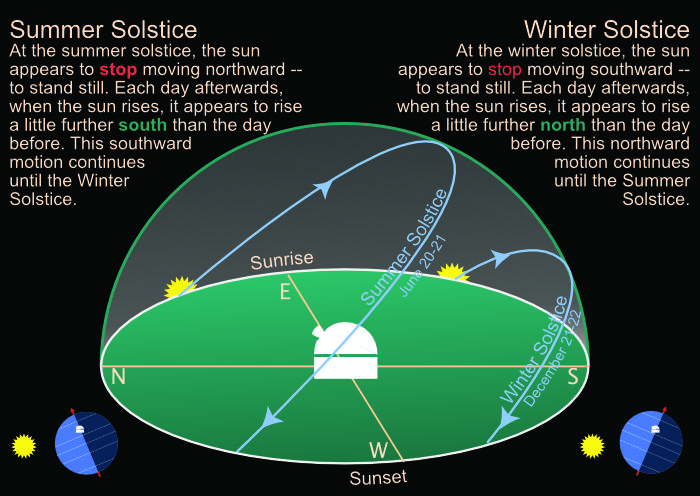| 2020 Jun 20: The Summer Solstice Arrives (2020-6-04) ⬅︎ |
 |
If you ask people what the summer solstice means, you may get lots of different answers...
* Many may say it's the start of summer.
* Others may say it is the longest day of the year.
* And a few may say it is the day in which the sun reaches it highest altitude in the sky.
While there's truth to all these answers -- assuming you don't live in the tropics -- the best answer is that
the summer solstice is the day in which earth has its maximum tilt toward the sun.
While it may be a bit difficult to understand the geometry -- it took our ancestors a long time to figure this
out -- it's actually easy to see it happening, even from your own neighborhood. Go outside right before sunrise on
as many days as you can starting at least a week before the
summer solstice and continue until at least a week after. Watch the sun rise and make a note of where the sun
rises along the horizon each day. Better yet, take a photo of it when it first appears each time.
What you'll see is that on each day before the solstice, the sun will appear further north on the horizon than the
day
before. On the day of the solstice, it will seem to 'stand still' -- not be further north. Then, on each day after the
solstice, the
sun will
appear further south on the horizon than the day before.
The diagram above shows the 'bigger' picture. You'll see that from the first day of winter around
December 21/22, to the first day of summer around June 20/21, the sun appears to 'spring' north a little bit from
one day to the next. And, from the first day of summer to the first day of winter, it appears to 'fall' south a little bit
each day. So it Springs after the start of Winter and Falls after the start of Summer... hmmm.
On the first day of winter or summer, the sun appears to stop this motion, or stand still, before reversing direction.
The Latin word that means 'sun stand still' is 'solstitium'. Our word 'solstice' comes from this.
Although our ancestors knew about how the sun rises differently each day and about the solstices, they didn't
understand
the
reason. Today, we know this motion is because Earth revolves the sun as it spins tilted over at a 23° angle. Got it?
Be sure to check out our Star Guide feature with its tools for knowing what's out each night and where to
look.
|
| |



